
The name Palais Ferstel feels a little deceptive. You might imagine a townhouse built for a Count Ferstel and his family, ready for their regular jaunts to the Viennese court. But you’d be wrong.
- Bank and stock market building from 1860
- Ferstel was the architect
- Remarkable neorenaissance architecture
- Home to the legendary Café Central (go inside!)
- Book a themed guided tour* of Vienna
- See also:
The Ferstelpalais
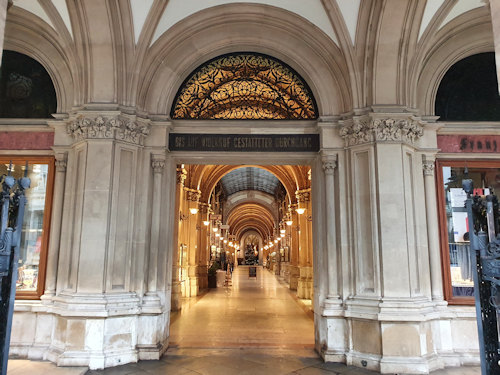
(View down the Ferstel Passage)
Palais Ferstel has carved out a special place in the landscape of Vienna’s old town.
For a start, the building extends along three streets, but you won’t find a continuous façade.
The main part sits on the corner of Herrengasse and Strauchgasse, but a large enclosed passageway leads away from one side to emerge rather ostentatiously on the Freyung square between Palais Hardegg and Palais Harrach.
The aptly-named Ferstel Passage feels almost Gothic-like with its vaulted ceiling, the tall corridor now lined with small stores and cafés tending toward the more refined end of the consumer spectrum.
The national bank of the time constructed the palais building in the late 1850s, primarily for their own use but also to provide space for the stock market. The latter only stayed briefly, shifting to its own standalone location on Vienna’s great Ring boulevard around ten years later.
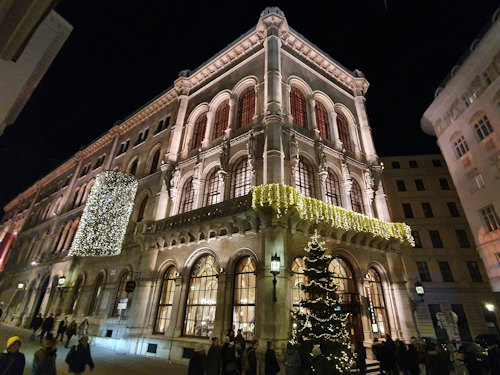
(A festively-decorated Palais Ferstel at the corner of Herrengasse and Strauchgasse)
If a look at the photos suggests a Renaissance feel to the architecture, that’s because architect Heinrich Ferstel pursued the historicism approach popular at the time (heavily influenced by a recent sojourn in Italy).
Ferstel also designed the Votivkirche, as well as other city landmarks like the MAK museum.
I’m not entirely sure quite when or why the location picked up its common moniker (possibly post-1980). Buildings tend not to be named after their architects, but Ferstel’s name now lives on in this rather gorgeous looking construction.
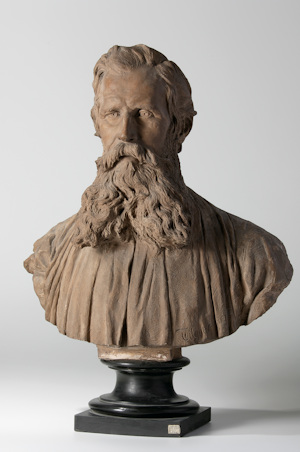
(Bust of the architect Heinrich Freiherr von Ferstel by Viktor Oskar Tilgner, 1877, Terrakotta, H. mit Sockel: 66.8 cm, Belvedere, Wien, Inv.-Nr. 128 © Belvedere, Wien. Reproduced with permission under the terms of Creative Commons License CC BY-SA 4.0.)
The palais must have been quite a sight when built.
An article in a 1860 edition of the Wiener Zeitung complains, for example, about the apparent indifference of the Viennese to all the delightful new buildings going up around them, noting (my translation):
Now you have to build something on the scale of the new bank and stock market to cause a sensation.
Another article later in the year in the same paper cited the influence of Venice and Florence on Ferstel’s design and announced (again, my translation):
Few buildings have attracted the attention of the educated public to such a degree as the new bank and stock market building on Herrengasse…
Not that Palais Ferstel remained such a glorious sight. World War II and the Russian army left the building in rather an undignified state.
Renovation work in the 1970s saw a return to former glories, though, and the palais now serves as a prestigious event venue. The WIKAM international Art and Antiques Fair takes place there, for example.
The coffee house
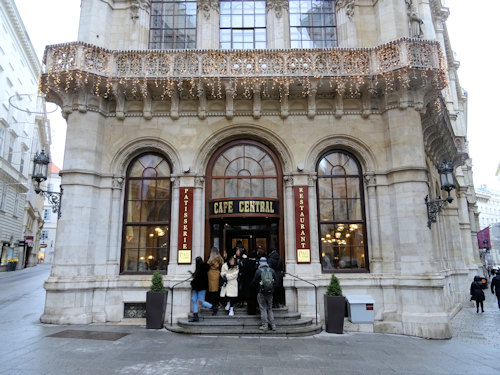
(Café Central without the normal queue)
Despite the bank connection, Palais Ferstel is perhaps best known for the ground floor coffee house.
First opened in 1876, Café Central became a meeting place for artists (like Oskar Kokoschka), writers (like Stefan Zweig), intellectuals (like Sigmund Freud), and politicians (like Leon Trotsky).
The café closed in 1943. Shortly afterwards, the great Austrian intellectual Alfed Polgar wrote (my translation):
Café Central is not a coffee house like other coffee houses, but a way of looking at the world; one whose central tenet is not to look at the world.
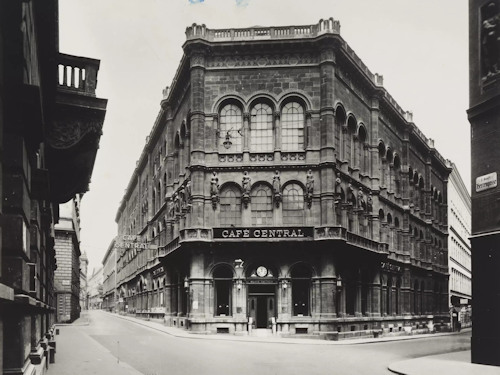
(Café Central, around 1905, photographed by Bruno Reiffenstein; Wien Museum Inv.-Nr. 184094; excerpt reproduced with permission under the terms of the CC0 licence)
Fortunately for us, Café Central reopened in the 1980s.
I’m a simple fellow, but the interior of today’s coffee house is quite breathtaking and gives you an idea of what the rest of the palais must look like.
Make a reservation if you wish to go: the architecture and rich history (and great cakes, it must be said) prove a magnet for tourists, with queues outside commonplace almost all year.
How to get to Palais Ferstel
Simply follow the tips given for Café Central. To see the Ferstel Passage, wander up to Herrengasse 14 where one end of the passage emerges and walk through to the Freyung.
Address: Strauchgasse 4, 1010 Vienna